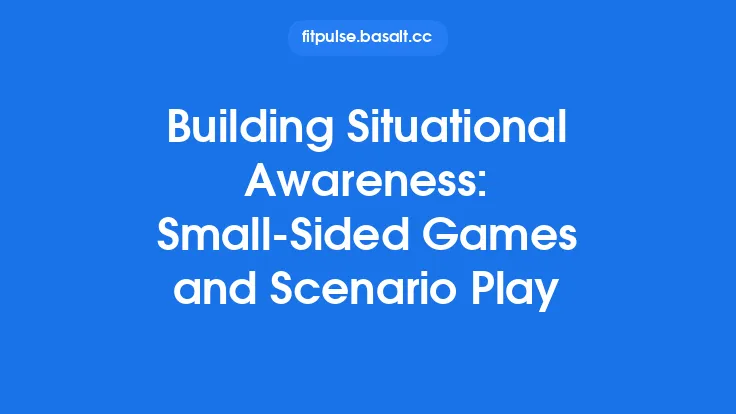Developing spatial awareness and positioning is at the heart of every successful team sport. Whether a player is patrolling the wings of a soccer pitch, sliding into the paint on a basketball court, or finding the gaps in a rugby defensive line, the ability to read, interpret, and occupy space efficiently separates good athletes from great ones. This article explores the foundational concepts, sport‑specific nuances, and practical pathways that coaches and athletes can use to cultivate lasting spatial intelligence across a variety of team environments.
Understanding Spatial Awareness
Spatial awareness is the cognitive ability to perceive the location, distance, and movement of objects—including teammates, opponents, and the boundaries of the playing area—relative to oneself. It integrates visual input, proprioceptive signals, and an internal representation of the field or court. Two core components underpin this skill:
- Perceptual Mapping – The brain constructs a mental map of the environment, constantly updating it as players move. This map includes static elements (lines, goals, benches) and dynamic elements (players, the ball/puck).
- Action‑Centric Calibration – The athlete translates the mental map into purposeful movement, adjusting speed, direction, and body orientation to occupy optimal positions.
Both components develop through repeated exposure, deliberate practice, and feedback loops that reinforce accurate perception‑action coupling.
The Role of Perception in Positioning
Effective positioning begins with what the athlete sees—and how the brain interprets it. Key perceptual cues include:
- Depth Cues: Relative size, occlusion, and motion parallax help gauge distance to teammates and opponents.
- Angular Velocity: The rate at which an object moves across the visual field signals its speed and trajectory.
- Peripheral Vision: Allows athletes to monitor multiple points of action without shifting focus, essential for maintaining awareness of off‑ball movement.
- Head and Eye Positioning: A slightly lowered head and wide visual field improve the detection of subtle shifts in opponent positioning.
Training the visual system to prioritize these cues—through activities such as “visual scanning drills” that emphasize rapid head turns and peripheral checks—strengthens the brain’s ability to generate accurate spatial maps in real time.
Sport‑Specific Geometries
Each team sport imposes a unique geometric framework that shapes spatial decision‑making. Understanding these frameworks helps athletes internalize the “shape” of their sport.
| Sport | Primary Playing Surface | Key Geometric Zones | Typical Positional Challenges |
|---|---|---|---|
| Soccer | Rectangular pitch (≈105 × 68 m) | Penalty box, midfield channel, wings | Maintaining width, timing runs into space |
| Basketball | Rectangular court (28 × 15 m) | Paint, three‑point arc, baseline | Balancing spacing for drives and off‑ball cuts |
| Rugby Union | Rectangular field (≈100 × 70 m) | 22‑meter line, ruck area, touchlines | Aligning defensive line, exploiting gaps |
| Ice Hockey | Rink (≈61 × 26 m) | Neutral zone, offensive/defensive zones | Rapid line changes, maintaining lane integrity |
| Volleyball | Rectangular court (18 × 9 m) | Front/back rows, attack line | Rotational positioning, covering angles of attack |
By studying the spatial constraints and opportunities inherent in these zones, athletes can develop sport‑specific heuristics—mental shortcuts that guide positioning without conscious deliberation.
Developing a Spatial Map
Creating a reliable internal map involves three progressive stages:
- Static Familiarization – New players spend time walking the field, noting landmarks, line markings, and typical player clusters. This “ground‑truthing” anchors the mental map to real‑world coordinates.
- Dynamic Observation – While watching live or recorded play, athletes focus on how the ball/puck moves through space and how players adjust their positions in response. The goal is to link visual cues to positional outcomes.
- Embodied Replication – Players then replicate observed patterns on the field, using their own bodies to reinforce the map. Repetition solidifies the neural pathways that translate perception into movement.
Communication and Shared Awareness
Spatial awareness is not an isolated skill; it thrives on collective understanding. Effective teams develop a shared spatial language:
- Verbal Cues: Short, standardized calls (“left‑back!”, “overlap!”, “drop”) convey intent and coordinate movement.
- Non‑Verbal Signals: Hand gestures, eye contact, and body orientation provide instantaneous feedback, especially in noisy environments.
- Pre‑Play Alignment: Before a set piece or offensive play, teams often align in a formation that visually reinforces each player’s role and space.
Coaches should nurture these communication habits, ensuring that every player can both read the field and broadcast their own spatial intentions.
Positioning Principles by Sport
Soccer
- Maintain Width: Full‑backs and wingers should stretch the opposition horizontally, creating channels for midfield penetration.
- Triangular Support: Players form passing triangles, ensuring at least two options are always available within a 10‑meter radius.
- Off‑The‑Ball Runs: Timing runs into pockets of space behind the defensive line forces the opponent to adjust, opening lanes for teammates.
Basketball
- Spacing Balance: A minimum of 2.5 m between players on the perimeter prevents defensive help and opens driving lanes.
- Paint Occupancy: Centers and power forwards must control the low‑post area, while guards occupy the high‑post to facilitate ball reversal.
- Cut Timing: Off‑ball cuts should intersect the ball‑handler’s passing lane at the moment of the pass, maximizing efficiency.
Rugby Union
- Defensive Line Integrity: Each defender must stay aligned with the off‑side line, maintaining a uniform distance (≈1 m) from the player ahead.
- Ruck Support: Players arrive at the ruck from a staggered angle, ensuring quick ball recycling while protecting the space behind.
- Kick Return Positioning: The back three must position themselves to cover the full width of the field, ready to field kicks and launch counter‑attacks.
Ice Hockey
- Neutral Zone Traps: Forcing opponents into a compressed neutral zone limits their passing options and creates turnover opportunities.
- Lane Discipline: Defensemen occupy the left and right “lanes” along the boards, preventing cross‑ice passes.
- Rotational Shifts: Players rotate positions fluidly during offensive rushes, maintaining coverage while creating shooting lanes.
Volleyball
- Rotational Coverage: Each rotation ensures that the front row covers the net while the back row protects the deep court.
- Angle of Attack: Attackers position themselves to hit at the optimal angle (≈30°) relative to the setter, maximizing spike effectiveness.
- Defensive Positioning: Liberos and defensive specialists read the hitter’s approach to anticipate ball trajectory and occupy the most likely landing zone.
Training Strategies for Spatial Awareness (Evergreen)
While specific drills are abundant, the underlying training philosophy remains constant: exposure, reflection, and adaptation.
- Guided Walk‑Throughs – Before a session, coaches walk the team through the playing area, highlighting key zones and typical movement patterns.
- Scenario Visualization – Athletes spend a few minutes each day mentally rehearsing common game situations, picturing themselves moving into optimal positions.
- Live “What‑If” Adjustments – During scrimmages, coaches pause play to ask players where they would position themselves given a particular ball location or opponent movement, encouraging immediate cognitive recalibration.
- Positional Shadowing – Less experienced players shadow a seasoned teammate, mirroring their movement and decision‑making in real time. This observational learning reinforces spatial heuristics.
- Feedback Loops – After each practice segment, a brief debrief focuses on spatial successes and missteps, allowing athletes to internalize corrective insights.
These strategies are adaptable across sports and age groups, providing a timeless framework for building spatial intelligence.
Integrating Proprioception and Kinesthetic Feedback
Spatial awareness is not purely visual; the body’s sense of position (proprioception) and movement (kinesthesia) are equally vital. Enhancing these senses can be achieved through:
- Balance Challenges: Single‑leg stands on unstable surfaces improve joint position sense, which translates to better foot placement on the field.
- Closed‑Eye Movement Drills: Performing short, controlled movements with eyes closed forces reliance on internal cues, sharpening body awareness.
- Resistance Band Patterns: Multi‑directional resistance work trains muscles to respond to spatial demands, such as rapid lateral shuffles or diagonal cuts.
When athletes trust their body’s internal map, they can react faster and more accurately, especially under high‑speed conditions.
Coaching Cues and Feedback
Effective coaching language for spatial development is concise, visual, and action‑oriented:
- “Find the lane” – Encourages players to identify and occupy the space between defenders.
- “Stay on the line” – Reinforces defensive alignment and off‑side discipline.
- “Create the triangle” – Prompts formation of passing options.
- “Cover the angle” – Directs defensive players to protect the most dangerous shooting or passing corridor.
Feedback should be immediate and specific, linking the observed positioning to the outcome (“You were a step too deep, giving them space to turn”). Over time, this reinforces the correct spatial habits.
Long‑Term Development Pathways
Spatial awareness evolves with age, experience, and sport specialization. A progressive pathway might look like:
| Age/Stage | Focus | Typical Activities |
|---|---|---|
| U‑8 to U‑10 | Basic field/court familiarity | Walking the surface, simple “find the cone” games |
| U‑12 to U‑14 | Recognizing zones and basic patterns | Guided scenario walkthroughs, shadowing |
| U‑16 to Senior | Dynamic spatial decision‑making | Live “what‑if” adjustments, positional shadowing, mental rehearsal |
| Elite | Refinement under pressure | High‑tempo scrimmages with real‑time feedback, advanced visualization |
Coaches should align training intensity with the athlete’s developmental stage, ensuring that spatial concepts are introduced early and refined continuously.
Common Pitfalls and How to Avoid Them
| Pitfall | Why It Happens | Remedy |
|---|---|---|
| Over‑Emphasis on Static Drills | Coaches may rely on repetitive, non‑dynamic exercises that don’t mimic game flow. | Incorporate live, fluid scenarios that require constant repositioning. |
| Neglecting Peripheral Vision | Players focus narrowly on the ball, missing off‑ball movement. | Include drills that force athletes to scan 360°, such as “head‑up” scrimmages. |
| Relying Solely on Verbal Instructions | Verbal cues can be lost in noisy environments. | Pair verbal calls with hand signals and body language. |
| Ignoring Individual Body Types | One‑size‑fits‑all positioning can limit effectiveness. | Tailor spatial responsibilities to each player’s speed, reach, and agility. |
| Lack of Reflective Debrief | Players may repeat the same spatial errors. | Conduct brief post‑session reviews focusing on positioning decisions. |
By proactively addressing these issues, teams can maintain a clear trajectory toward superior spatial competence.
Bringing It All Together
Spatial awareness and positioning are the invisible scaffolding upon which every tactical plan is built. By understanding the perceptual foundations, respecting sport‑specific geometries, fostering shared communication, and applying timeless training principles, coaches can nurture athletes who instinctively occupy the right space at the right time. This evergreen knowledge not only elevates individual performance but also amplifies collective cohesion, giving teams the strategic edge needed to thrive in any competitive arena.




